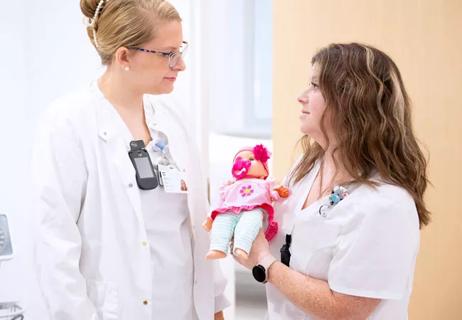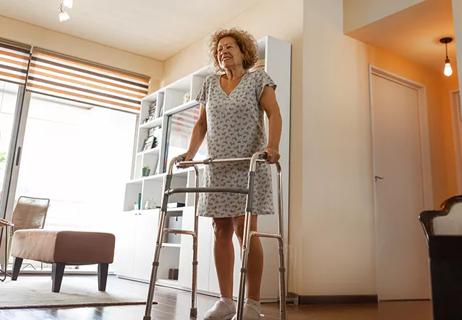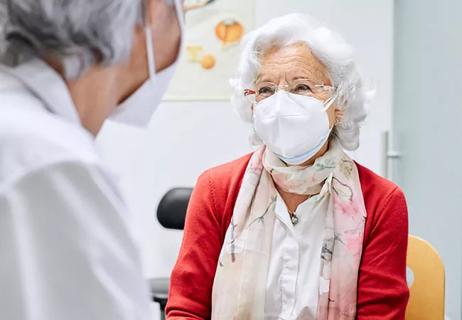Pilot program frees up nurses for clinical activities

In August, Cleveland Clinic’s Fairview Hospital began a pilot program on a 24-bed medical-surgical unit to provide social and cognitive stimulation for patients 65 years and older who express loneliness or have no or minimal visitors.
Cleveland Clinic is a non-profit academic medical center. Advertising on our site helps support our mission. We do not endorse non-Cleveland Clinic products or services. Policy
“The literature reveals the potential for decreased prevalence of delirium, improved patient mood and increased food intake with visits during mealtimes,” says Stacey Claus, MSN, RN, GCNS-BC, CNRN, Clinical Nurse Specialist in Medical-Surgical Nursing at Fairview Hospital. “We’re also hoping to meet the needs of volunteers who want more patient interaction and support nurses who feel like quality patient time is not something they can accomplish.”
Inspiration for the program began at an interprofessional meeting of the Nurses Improving Care for Healthsystem Elders (NICHE) Steering Committee. Tina Jacobs, Director of Volunteer Services at Fairview Hospital, indicated that some volunteers wanted to have more interaction with patients. “The volunteers were helping patients immensely by providing discharge transport, delivering specimens and so on, but that was indirect help,” says Claus. “They wanted something more.”
Claus shared this feedback at a Geriatric Resource Nurse Committee meeting. Maggie Marniella, RN, a clinical nurse and geriatric resource nurse on the 6N/6S medical-surgical unit, expressed interest in helping develop a volunteer visitation program. “A lot of times when the older population are hospitalized, they get lonely when they’re in the room alone for a long time,” says Marniella. “We felt this program would be good for the patients, as well as give volunteers more one-on-one time with patients.”
Nearly a dozen volunteers signed up to participate in the “Volunteers as a Caring Presence” pilot program. At the onset of the program, they were available in four-hour shifts between 8 a.m. and 4 p.m., Monday through Friday. Nurses on 6N/6S identified patients who would benefit from visitation, then volunteers reviewed the list and began rounding on patients. The volunteers provided the following:
Marniella created an activity cart that volunteers can bring on their rounds. It includes coloring books, large-print spiritual publications and quilting activity blankets. It also has comfort items that patients might typically use at home, such as warm socks, tissues and reading glasses.
Prior to launching the program, the volunteers participated in a three-hour training session to discuss expectations. Marniella and Jacobs reviewed the job description, talked about safety considerations and provided education on the geriatric population, including information on dementia-friendly and aging-sensitive communication. They also conducted a role-playing activity with different scenarios the volunteers might face. Finally, the volunteers toured 6N/6S to learn the location of blankets, the ice machine, the activity cart and other supplies they might need.
Marniella, Claus and Jacobs are currently tweaking the program to achieve the best results. For example, they discovered that scheduling volunteers for four-hour blocks of time wasn’t always optimal. Sometimes there weren’t enough patients to visit to fill the time. So they are considering other options, such as sending volunteers to the unit a couple times during each shift to see if any visitors are required.
Despite some glitches, the pilot program is working well overall. Marniella says they have gotten really good feedback from patients, nurses and volunteers. “One volunteer shared that he visited with someone from his neighborhood and had a great time reminiscing with the patient,” says Claus. “A couple of retired nurses have asked to join the group because they love the idea and know how hard it is for nurses to provide the kind of time they want to with patients.”
Marniella concludes, “The program is a work in progress, but it’s been well received.”

Pilot study confirms feasibility of conducting additional research on the novel treatment

Longer hospitalization does not mean a safer, faster recovery for patients age 70+

Structured data helps identify older adults at risk for poor outcomes, defines patients who require more comprehensive assessments

Self-administered tool can be completed in 10 minutes in waiting room

Social prescribing turns leisure activities into good “medicine”

A large geriatric study aims to find the answers

Analysis underscores how telehealth can help pinpoint elder abuse